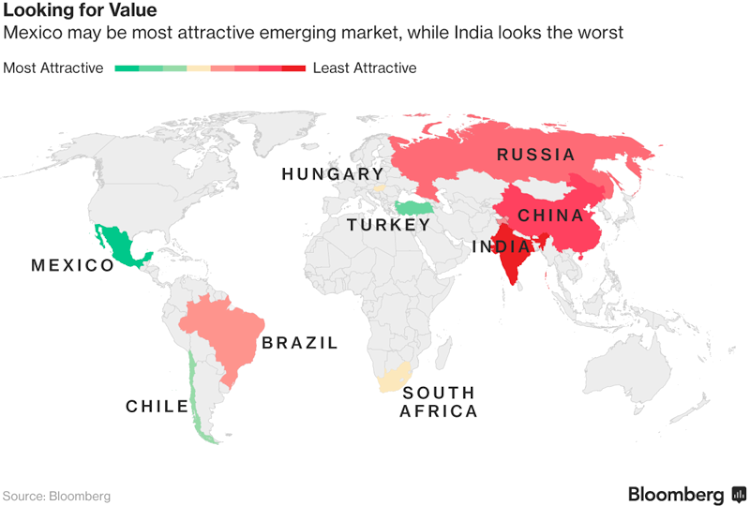Singapore/Bangkok — Mexico is the most attractive emerging market for investors, based on a range of metrics analysed by Bloomberg including growth, yields and equity valuations. India is the worst.
Mexico’s currency slid and bond yields surged as President Donald Trump was elected in November after lambasting the country for stealing US jobs. Even after an initial sell-off subsided, the 10-year bond yield is still more than a percentage point above where it was before the election. The peso’s real-effective exchange rate is close to a 21-year low, boosting the earnings outlook for exporters.
“Both Mexico’s currency and bonds have been sold too much,” said Akira Takei, who helps oversee the equivalent of $440bn as a fund manager at Asset Management One Company in Tokyo. He said the expectation the dollar would weaken had convinced him to hold a higher proportion of pesos and Mexican government bonds in his portfolio than recommended by the benchmarks he followed.
Analysts have raised the fourth-quarter peso forecast by almost 5% to 20.50 to the dollar since February as Mexico’s currency retraced some of the declines that started in November.
India is the least attractive developing nation for investors due to its relatively expensive stocks, bonds and currency. India’s NSE Nifty 50 index rose to a record and the Sensex climbed to a two-year high last week as the electoral victory of Prime Minister Narendra Modi’s party in the nation’s biggest state sparked optimism he will accelerate reforms, including the introduction of a goods and services tax.
The new tax “is a great thing in the medium term, but there will be some disruption to consumption in the months following its introduction”, said Vaninder Singh, an economist at NatWest Markets in Singapore.
Singh agrees India appears unattractive for investors at the moment. “You will have to see a correction in the equity markets, and as a consequence the Indian rupee as well.”
Metrics
Bloomberg’s analysis covers nine of the 10 countries making up JPMorgan Chase & Company’s Emerging Market Currency index. Singapore is excluded as it is considered to be a developed nation.
The attractiveness of each country is computed for the following criteria, with forecasts compiled from Bloomberg surveys of analysts and economists:
The result for each is shown as a Z-score, which measures the relationship of the individual value to the mean. The scores are computed based on the five-year average between one country’s variable and the mean of the nine emerging markets.
The results for stock price:earnings ratios, real effective exchange rate and foreign-exchange volatility are reversed as higher figures mean they are less attractive for investors.
GDP growth measures the potential for asset returns, while the current-account balance indicates the risk of a currency crisis. Equities, government bonds and currencies represent major investment classes. Implied volatility gauges risks to carry trade.
The credit rating is a proxy of the riskiness of government bonds and currencies. Ratings are based on Moody’s Investors Service, and the alphabetical symbols are converted into numbers, with Aaa given a value of 20 and C representing zero.
Bloomberg



